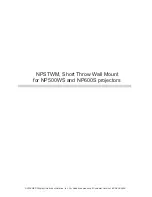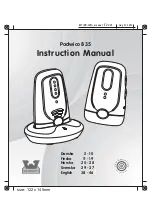
IOM-WR-Snow_Ice-090_09 324
4 of 8
. Cut four pieces of rebar at least 2" (300 mm) long.
2. Drive the rebar into the ground through each of the mounting plate rebar
holes. Leave approximately 2" (50 mm) of rebar above the ground.
3. Cut several 2" (300 mm) pieces of steel wire.
4. Form a “U” shape and pull wire through the rebar tie hole from the bottom
to the top side.
5. Repeat by pulling the “U” shape from the top to the bottom side.
6. Repeat (4) and (5) for each of the four corners.
7. Cross the wire, then wrap around the rebar.
8. Twist wire using pliers to tighten.
The mounting plate also has conduit tie holes to allow a cable tie or steel wire to
fasten the conduit to the mounting plate.
Placing Concrete
---------------------------------------------------
A plastic plug is provided with the socket to prevent it from being accidentally filled with
concrete. The plastic plug is the same thickness as the sensor flange. This allows the
finished surface of the concrete (asphalt, etc.) to be troweled flush with the plug. The
plug must be installed prior to placing the concrete. Also ensure that the mounting
plate drainage hole remains unplugged once the concrete has cured.
Installing Brick Pavers
----------------------------------------------
If using brick pavers instead of concrete, it is recommended to mortar surrounding
brick pavers to the side of the socket. This ensures good thermal conduction from
the brick pavers to the socket. The top of the brick pavers should be level with the
socket when the plastic plug is installed.
Install the Sensor and Cable
----------------------------------------
When the snow melt surface is finished,
remove the plastic plug from the socket
and fish the cable through the conduit until
there is only 6 to 2
"
(50 to 300 mm) of
cable between the sensor and conduit.
Loop this remaining extra wire in a loose
coil so as to not twist it, and place it, and
the sensor into the socket. Secure the
sensor to the socket with the four screws
provided, making sure the “O” ring is in
place and properly seated.


























